
The "Republican Revolution", "Revolution of '94", or "Gingrich Revolution" are political slogans that refer to the Republican Party (GOP) success in the 1994 U.S. mid-term elections, which resulted in a net gain of 54 seats in the House of Representatives, and a pick-up of eight seats in the Senate. On November 9, 1994, the day after the election, Senator Richard Shelby of Alabama, a conservative Democrat, changed parties, becoming a Republican; on March 3, 1995, Colorado Senator Ben Nighthorse Campbell switched to the Republican side as well, increasing the GOP Senate majority.
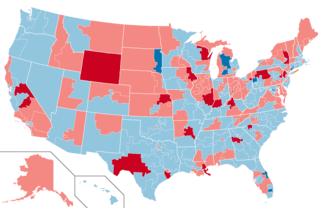
The 1978 United States House of Representatives elections was an election for the United States House of Representatives in 1978 which occurred in the middle of Democratic President Jimmy Carter's term, amidst an energy crisis and rapid inflation. The Democratic Party lost a net of 15 seats to the Republican Party, and thus lost their two-thirds supermajority, but still maintained a large 277-seat majority.

The 1962 United States elections were held on November 6 to elect the members of the 88th United States Congress. The election occurred in the middle of Democratic President John F. Kennedy's term. The Republican Party picked up four seats in the House of Representatives, but the Democrats retained strong majorities in both houses of Congress. In the Senate, Democrats won a net gain of four seats from the Republicans, maintaining control of the Senate. In the gubernatorial elections, neither party won a net gain of seats. Notably, 1960 Republican presidential nominee Richard Nixon lost the California gubernatorial election, which many analysts, as well as Nixon himself, incorrectly predicted to be the end of his political career.

The 2010 United States elections were held on Tuesday, November 2, 2010, in the middle of Democratic President Barack Obama's first term. Republicans ended unified Democratic control of Congress and the presidency by winning a majority in the House of Representatives.

The 1980 United States elections were held on Tuesday, November 4. Republican presidential nominee Ronald Reagan defeated incumbent Democratic President Jimmy Carter. Republicans also won control of the Senate, though Democrats retained a majority in the House of Representatives. The election is sometimes referred to as part of the "Reagan Revolution", a conservative realignment in U.S. politics, and marked the start of the Reagan Era.

The 2002 United States elections were held on November 5, in the middle of Republican President George W. Bush's first term. Republicans won unified control of Congress. In the gubernatorial elections, Democrats won a net gain of one seat. The elections were held just a little under fourteen months after the September 11 attacks. Thus, the elections were heavily overshadowed by the War on Terror, the impending Iraq War, the early 2000s recession, and the sudden death of Democratic Senator Paul Wellstone of Minnesota about one week before the election.
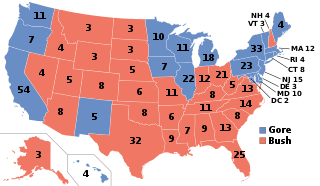
The 2000 United States elections were held on November 7, 2000. Republican Governor George W. Bush of Texas defeated Democratic Vice President Al Gore of Tennessee in the presidential election. Republicans retained control of both houses of Congress, giving the party unified control of Congress and the presidency for the first time since the 1954 elections.

The 1998 United States elections were held on November 3, 1998 in the middle of Democratic President Bill Clinton's second term. Though Republicans retained control of both chambers of Congress, the elections were unusual in that the president's party gained seats in the House of Representatives.

The 1994 United States elections were held on November 8, 1994. The elections occurred in the middle of Democratic President Bill Clinton's first term in office, and elected the members of 104th United States Congress. The elections have been described as the "Republican Revolution" because the Republican Party captured unified control of Congress for the first time since 1952. Republicans picked up eight seats in the Senate and won a net of 54 seats in the House of Representatives. Republicans also picked up a net of ten governorships and took control of many state legislative chambers.

The 1996 United States elections were held on November 5. Democratic President Bill Clinton won re-election, while the Republicans maintained their majorities in both houses of the United States Congress.
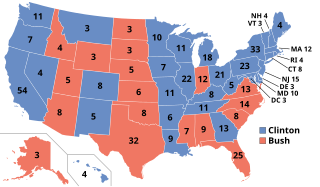
The 1992 United States elections elected state governors, the President of the United States, and members of the 103rd United States Congress. The election took place after the redistricting that resulted from the 1990 Census. Democrats won control of the presidency and both chambers of Congress for the first time since the Republican victory in the 1980 elections.
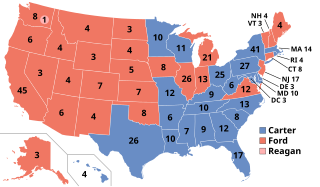
The 1976 United States elections was held on November 2, and elected the members of the 95th United States Congress. The Democratic Party won the presidential election and retained control of Congress.

The 1984 United States elections was held on November 6, and elected the members of the 99th United States Congress. Republicans won a landslide victory in the presidential election, picked up seats in the House of Representatives, and successfully defended their Senate majority.

The 1988 United States elections were held on November 8 and elected the members of the 101st United States Congress. The Republican Party retained the presidency, while the Democratic Party retained control of Congress.

The 1968 United States elections were held on November 5, and elected members of the 91st United States Congress. The election took place during the Vietnam War, in the same year as the Tet Offensive, the assassination of Martin Luther King, Jr., the assassination of Robert F. Kennedy, and the protests of 1968. The Republican Party won control of the presidency, and picked up seats in the House and Senate, although the Democratic Party retained control of Congress.

The 1946 United States elections were held on November 5, 1946, and elected the members of the 80th United States Congress. In the first election after World War II, incumbent President Harry S. Truman and the Democratic Party suffered large losses. After having been in the minority of both chambers of Congress since 1932, Republicans took control of both the House and the Senate.
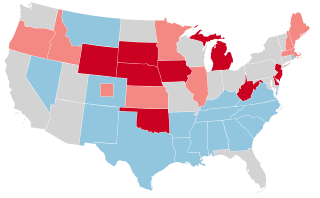
The 1942 United States elections were held on November 3, 1942, and elected the members of the 78th United States Congress. In Democratic President Franklin D. Roosevelt's unprecedented third mid-term election, the Republican Party picked up seats in both chambers. In the House of Representatives, the Democrats lost forty-five seats, mostly to Republicans. The House elections took place after the 1940 United States Census and the subsequent Congressional re-apportionment. The Democrats also lost eight seats to the Republicans in the U.S. Senate. An Independent also lost his seat to a Republican in the Senate. Despite Republican gains, the Democratic Party retained control of both chambers. The election was a victory for the conservative coalition, which passed the Smith-Connally Act and abolished the National Resources Planning Board over the objections of Roosevelt.

The 2018 United States elections were held on Tuesday, November 6, 2018. These midterm elections occurred during Republican Donald Trump's term. Democrats made a net gain of 41 seats in the United States House of Representatives, gaining a majority in the chamber and thereby ending the federal trifecta that the Republican Party had established in the 2016 elections. The Republican Party retained control of the United States Senate, making a net gain of two seats and defeating four Democratic incumbents in states that had voted for Trump in 2016. As a result of the 2018 elections, the 116th United States Congress became the first Congress since the 99th United States Congress in which the Democrats controlled the U.S. House of Representatives and the Republicans controlled the U.S. Senate.

The 1906 United States elections elected the members of the 60th United States Congress. It occurred in the middle of Republican President Theodore Roosevelt's second term, during the Fourth Party System. Republicans retained control of both houses of Congress.
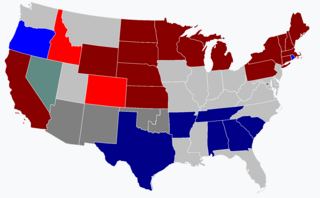
The 1902 United States elections elected the 58th United States Congress, and occurred in the middle of Republican President Theodore Roosevelt's first term, during the Fourth Party System. Roosevelt had become president on September 14, 1901, upon the assassination of his predecessor, William McKinley. Republicans retained a majority in both chambers of Congress, while the Populist Party and Silver Republican Party disappeared from Congress.






















